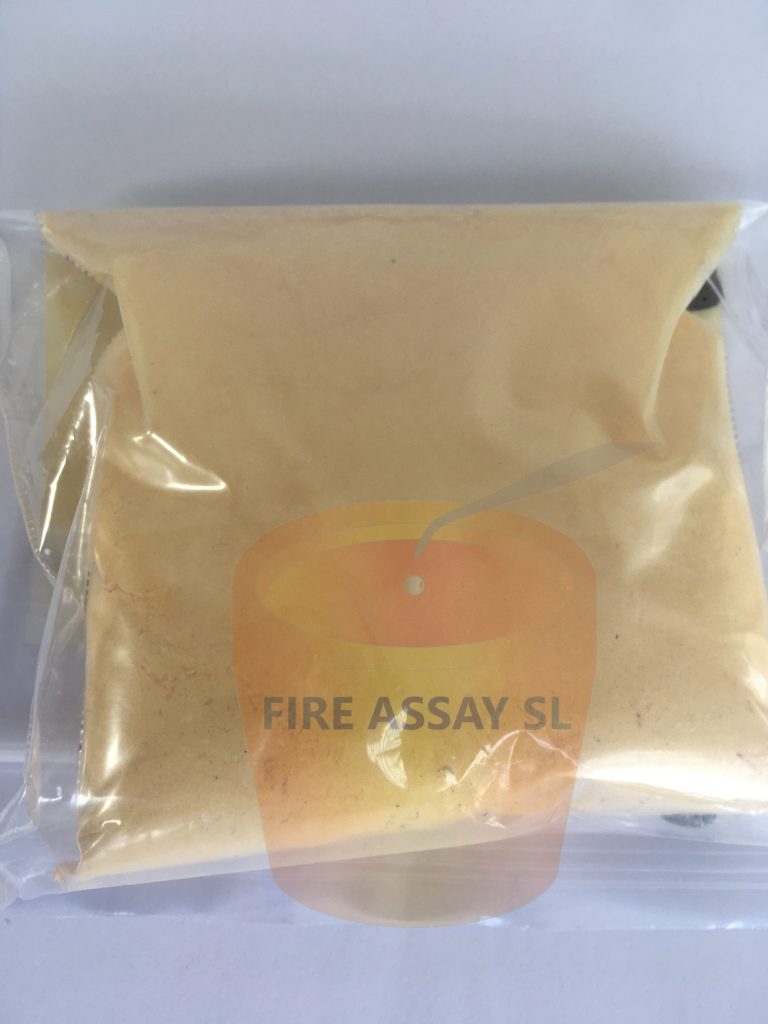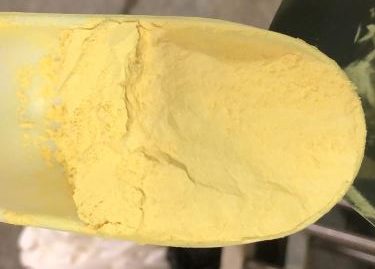FIRE ASSAY FLUX
Fire Assay SL supplies all the necessary flux components for the fire assay process, and also pre-mixes them according to your own recipe. Externalising the production of your fire assay flux not only saves time, but also avoids handling hazardous chemicals in your laboratory.
A flux converts infusible compounds at a certain temperature into others which melt at this temperature.
In general terms, in order to fuse an acid substance, it is necessary to employ a basic flux such as litharge or sodium carbonate.
On the other hand if we want to fuse a basic substance, we will use an acid flux such as silica or borax.
A desulphurizing agent is a substance which has a strong affinity for sulphur and which is therefore capable of separating it from some of its compounds

FIRE ASSAY PREMIXED FLUX
We manufacture premixed flux according to customer recipe. This means that customers can provide their own specific formula for the flux, and we will produce it to their exact specifications. We can also pack it accoring custumer requirements: crate, pail, big bags or other required formats.
Here are some of the benefits of externalising the production of premixed flux :
- Customized flux: Customers can get exactly the flux they need for their specific application.
- Convenience: Customers do not have to worry about mixing their own flux. This reduces both the handling of hazardous litharge in the laboratory, and also saves time.
- Cost-effective: It can be more cost-effective to have Fire Assay SL manufacture premixed flux according to customer recipe than to do it in house.



Assay grade Litharge (PbO) is the key ingredient of assay flux. During the reductive fusion that takes place in the fire assay crucible, Litharge has the following functions:
- Collector: When Litharge reduces into lead, it rains downd under the form of droplets through the sample collecting all metals
- Fluxing agent
- Desulphuriser: Prevents the formation of ‘Matte’ (by oxidation of sulphurs)
- Solvent: Litharge acts as a solvent for metallic oxides
- Prevents formation of ‘Speiss‘ (by oxidation of antimony and arsenic).
- Prevents reduction into lead button of those metals below lead in the redox potential series.
- Combined with acid reagents PbO forms an efficient Solvent for acid and basic Oxide Compounds that are too viscous at furnace temperature.
Our litharge is under the form of 25 kg bags, and is gold and silver free.
ASSAY GRADE SILVER NITRATE AND ASSAY SILVER SULFATE
It is possible to add the silver for inquartation directly into the mix under the form of silver nitrate or silver sulfate.
Our assay silver nirate has a silver content of more than 63.4%, (99.9% AgNO3) and gold content of les than 1 ppb. Regarding hte silver silver sulfate (99.9% Ag2SO4), its silver content is 69.1% qand has also a gold content of less than 1ppb.
It is also possible to add the silver for inquartation directly under the form of metallic silver. For this, we supply pure silver inquarts of 1, 2, 4, 5, 6, 10, 15 and 20mg, or also silver inquarts alloyed with lead to ease their handling.
ASSAY ANHYDROUS SODIUM CARBONATE
Sodium Carbonate (Na2CO3) or soda ash is a powerful basic assay flux and one of the cheapest available for assay purposes:
- As it easily forms sulphates and sulphides, it helps desulphurizing the sample (helps preventing the apparition of Matte) .
- The other reason for using sodium carbonate, is that it has fluxing effects. Indeed, it contributes to reduce the melting temperature of the mixture by forming eutectics.
We recommend using dense sodium carbonate because it absorbs very little atmospheric moisture, and therefore has a longer shelf live.
| Na2CO3 | As | NaCl | Fe2O3 | Hg | Pb | Na2SO4 |
|---|---|---|---|---|---|---|
| >99% | <2ppm | <0.25% | 35ppm | <1ppm | <2ppm | <300ppm |
ASSAY ANHYDROUS POTASSIUM CARBONATE
| K2CO3 | Na2CO3 | KCl | Fe | Moisture | Heavy metals (Pb) | K2SO4 | Particle size > 270 mesh |
|---|---|---|---|---|---|---|---|
| >98.5% | <1.2% | 0.01% | 3ppm | <0.6% | 5ppm | <0.01% | 30% |
Potassium Carbonate (K2CO3) is also a basic assay flux very similar to sodium carbonate, but is has the disadvantage of being more expensive.
However, adding small quantities of Potassium carbonate is interesting because it will contribute to reduce the melting temperature of the mixture in the fire assay crucible.
Indeed, a mixture of sodium and potassium carbonate melts at a lower temperature than either one alone, and for this reason the mixture is used whenever it is desired to maintain a low temperature during the assay. The lead assay is an example and in fact is now about the only case in which it is still customary to use potassium carbonate in fire assaying.
ASSAY ANHYDROUS BORAX
Borax (Na2B407) is almost always present in all Fire Assay fluxes because it greatly reduces the fusing point of all slags, and it is also an excellent solvent for metallic oxides.
At red heat anhydrous borax becomes a strong acid and practically dissolves all metallic oxides and fluxes, both acid and basic.
If too much borax is used in the assay of siliceous ores there results a very tough, glassy or stony slag which holds tenaciously to the lead button. This is probably due partly to the effect of borax in reducing the coefficient of expansion of the slag and partly to its action in preventing crystallization. When the attempt is made to separate the lead and slag, a film of lead will often adhere to the slag and give the assayer much trouble. The remedy for this condition is, first, to reduce the quantity of borax used and then, if necessary, to increase the bases.
| B2O3 | Equivalent Na2B4O7 | Na2O | H2O | SO4 | Fe | Particle size |
|---|---|---|---|---|---|---|
| 68.5-69.4% | 99.0-100.3 | 30.5-30.9% | <1% | <150ppm | 40ppm | 12-Mesh |
ASSAY ANHYDROUS POTASSIUM NITRATE
Commonly known as niter, this fire assay flux is a powerful oxidizing agent.
It melts at 339ºC and fuses at a low temperature without alteration, but at a higher temperature it breaks up, giving off oxygen, which oxidizes sulphur and many of the metals, notably lead and copper.
It is used in the fire assay especially to oxidize sulphides, arsenides, antimonides, etc.
Many assayers object to its use because of the oxidizing effect on silver. Large amounts of potassium nitrate or sodium nitrate cause boiling of the crucible charge and necessitate careful heating to prevent loss.
ASSAY ANHYDROUS SODIUM NITRATE
Sodium nitrate behaviour is very similar to the one of potassium nitrate. However sodium nitrate is cheaper.
ASSAY SILICA
| SiO2 | Al2O3 | Fe2O3 | TiO2 | CaO | MgO | Na2O | K2O | P2O5 | Moisture |
|---|---|---|---|---|---|---|---|---|---|
| 98.5% | <1% | <0.06% | 0.02% | 0.3% | 0,1% | 0.1% | 0.3% | 0.1% | <0.2% |
ASSAY FLUORSPAR / ASSAY CALCIUM FLUORIDE
Fluorspar (CaF2) is occasionally used as a flux in fire assaying. Its melting-point is 1378ºC and it would, therefore, seem to be of doubtful value in fire assay fusions which seldom exceed 1200ºC.
When melted it is very fluid and assists in fluidifying the charge, although it is inert and does not ordinarily enter into chemical combination with the other constituents of the charge.
It is particularly used when assaying bone ash.
| CaF2 | SiO2 | Carbonates | BaSO4 | Moisture |
|---|---|---|---|---|
| >97% | <1.1% | <1.5% | <0.5% | <0.2% |
ASSAY CREAM OF TARTAR
2KHC4H4O6 + heat = K2O + 5H2O + 6CO + 2C.
The K2O thus liberated is available as a flux.
Available purity is >99% and it is packed in bags of 25kg.
LANTHANUM OXIDE
| La2O3 | CeO2 | Pr6O11 | CuO | PbO |
|---|---|---|---|---|
| >99.99% | 0.0015% | 0.0015% | 0.005% | 0.005% |
99.99% purity lanthanum oxide for the analysis fo platinum and palladium. We can pack it according to any need.

